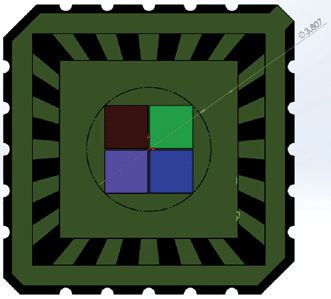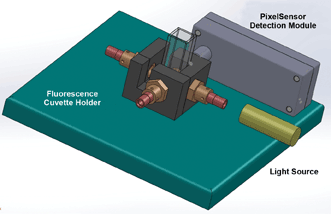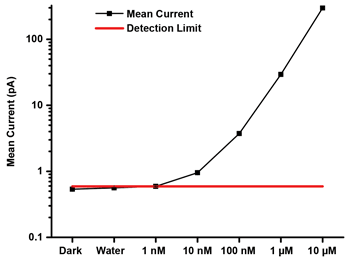Dr. Eric Chandler and Dr. Fiona Chan, Pixelteq
A new low-cost multispectral fluorescence detection sensor helps overcome barriers to using molecular diagnostics in point-of-care testing.
In molecular diagnostics, fluorescent probes are used for detection of specific genetic material associated with particular diseases, enabling physicians to make accurate diagnoses and to prescribe more personalized treatments. Equipment for sensitive fluorescence detection is, however, typically expensive and bulky. Furthermore, additional optical elements are required to perform spectral separation when using multiple fluorescent probes for multiplex testing. The added optical elements inevitably reduce the system’s affordability and robustness.
A compact module for multispectral fluorescence detection can reduce the size, complexity and cost of fluorescence-based molecular diagnostic instruments. Capable of detecting below 1 nM of fluorescein, the multispectral fluorescence sensor can help bring the power of molecular disease diagnostics to the point of care in both the developed and developing worlds.
The combination of reduced device cost and small footprint also opens doors to applications on lab-on-a-chip devices and in industrial applications such as forensics and pathogen detection in water, food and consumer products.
Multispectral fluorescence detection
Molecular diagnostic tests have improved health care in many ways. They enable blood tests for viruses such as hepatitis and HIV, increase the chance of success of cancer treatments by identifying a patient’s specific type of cancer, inform prospective parents of their risk of having a child with cystic fibrosis, protect women from breast and cervical cancer by identifying high-risk individuals, and detecting cancer early and more.

Figure 1. Complicated optics (a) can be replaced with PixelSensor (b) for multispectral fluorescence detection. The dichroic beamsplitters and filters in (a) typically cost $200 to $300 each. Images courtesy of Pixelteq.
Specific identification of biomolecules with fluorescent labeling is used in biological applications including flow cytometry and polymerase chain reaction (PCR). Cell populations can be sorted based on the presence of different-colored fluorophores in individual cells using flow cytometry. PCR testing is a highly sensitive technique in molecular diagnostics. In a PCR test, targeted DNA segments are amplified if present, and fluorescent probes that specifically hybridize to the targets and emit fluorescence can be detected optically in real time. Fluorescent probes of multiple colors allow multiple DNA targets to be detected in the same test. Both flow cytometry and PCR testing are based on reliable detection of just a handful of colors.
Multispectral fluorescence detection, however, is neither simple nor cheap. A conventional four-channel multispectral fluorescence-detection system requires three dichroic mirrors and four bandpass filters to spectrally separate the four wavelength ranges illustrated in Figure 1a. As a result, complex instrumentation required for multispectral fluorescence detection in this way hinders progress in taking the PCR test from centralized laboratories to the point of care, including hospitals, smaller clinics and patients in the developing countries. Overcoming this barrier by reducing the cost and size of PCR instruments will help bring molecular testing to the point of care and create a great impact on global public health.

Figure 2. Four coated photodiodes can be assembled in a common optical semiconductor package with the same 3.8-mm-diameter optical path occupied by a single filter and a TO-46 photodiode combination.
Point-of-care molecular testing
The PixelSensor, which contains multiple spectrally selective photodiodes in an area less than 1 cm2, is a compact and cost-reducing tool for multispectral fluorescence detection in PCR instruments. When a collimated beam of light shines onto the sensor, the intensity of multiple spectral bands can be measured individually, replacing the array of optical components that many currently use (Figure 1). Typically, each separate dichroic beamsplitter and optical filter costs $200 to $300. Furthermore, precise and sturdy hardware is required to ensure robust alignment of the multiple components in the conventional setup.
Advanced technology from Pixelteq simplifies the complex optical train traditionally needed into a single component. A specially designed photodiode substrate is selectively coated with interference filters using semiconductor microlithography processes. The optical filter directly deposited onto the wafer surface eliminates the need for separate photodiodes and optical filters, making the system more physically robust, and reducing the size and cost of components.

Figure 3. The PixelSensor can be used directly in a commercially available fluorescence cuvette setup for quick benchtop experiments.
The optical filter layer deposited can be custom-designed to any passbands in the VIS-NIR range (400-1000 nm). Thus, the sensor can be customized to suit specific fluorophores using deposited narrow bandpass filters that minimize spectral crosstalk. Four coated photodiodes can be assembled in a common optical semiconductor package with the same 3.8-mm-diameter optical path occupied by a single filter and a TO-46 photodiode combination, increasing the fluorescence-detection channels from one to four (Figure 2).
Experimental testingv
The sensor’s sensitivity for fluorescence detection was tested using fluorescein solution in a commercially available fluorescence cuvette setup (Figure 3).
A 2-mW, 445-nm diode laser was coupled through free space into the attached collimator of a four-way cuvette holder, the CUV-ALL-UV from Ocean Optics. Thorlabs’ fused-quartz cuvette held the fluorescein solution. Diluting fluorescein sodium made a fluorescein solution of 1 nM, 10 nM, 100 nM, 1 μM and 10 μM of salt (Sigma 46960) in deionized water. Fluorescence light was collected 90° to the excitation path and collimated onto the sensor, covering all of the required photodiode channels. Low-noise electronics, firmware and software were developed in-house. Current from the sensor was integrated over one second.

Figure 4. PixelSensor response to fluorescein fluorescence. The sensor can detect down to 1 nM of fluorescein and up to five decades of dynamic range in a commercially available fluorescence cuvette setup.
Figure 4 shows that the PixelSensor can detect 1 nM of fluorescein and up to five decades of dynamic range. The limit of detection is defined as mean signalblank + 3 × standard deviation of signalblank. Specially designed low-noise electronics using a current integration scheme enable sub-pA currents to be measured at high precision. Standard deviation of current signals was typically below 10 fA.
Meet the authors
Dr. Eric Chandler is an electro-optical scientist at Pixelteq; email: [email protected]. Dr. Fiona Chan is an applications scientist at Pixelteq; email: [email protected].